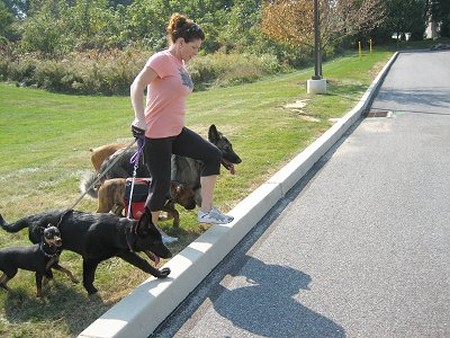To start teaching your dog using this method, you will need a check chain that fits it correctly, and a 6-ft (2-m) long webbing lead. Place the dog on-lead. Anchor the lead—that is, secure it tightly—in your right hand, and gather up the slack in your left hand.
Now, with your dog on your left side, start walking. Each time the dog pulls ahead, check it by making a backward motion with your left hand. Keep your elbow straight as you do, bending your body forward, and coming momentarily to a halt. Let your hand swing past your body as if you are marching, and then let it make a snap-release action in conjunction with the reprimand word. Then, as the lead becomes taut, immediately release the lead in your left hand. At the same time, growl your one-word reprimand. Praise your dog the moment it responds.
What you should be trying to achieve here is getting the check chain to make the clinking sound that your dog will respond to. Then, once the dog has heard the sound, you will be releasing the lead so that it receives a loose lead—this will discourage the pulling, because your dog is now being checked rather than being able to pull, as it loves doing.
Checking with the chain is a quick movement, a snap-release action: as the dog takes up all of the slack in the lead by pulling, you will again have to slacken it, in order to check the dog. In other words, to get a loose lead, you will have to move your hand forward, and then snap it backward. This is similar to the action of cracking a whip. Checking means, in effect, tightening and releasing the lead in quick succession, always leaving the dog with a loose lead. It is important to keep your elbow straight, and check straight back past your leg.
When the lead is loosened, the dog may at first try to run further away from you, but if it is checked it will try to avoid being in the same situation again. The next time the lead is loosened, it will learn to stay at the spot where it does not have to hear the checking sound right at your side.
Also, if you keep the lead loose, your dog will not be able to feel it, and will therefore not know if it is on- or off-lead. At a later stage, when you are doing off-lead training, you will find it very useful if your dog is already accustomed to the feeling of not being on a lead!
During on-lead training, be sure that you hold the lead loosely and only snap and release quickly, not holding the lead taut for any time at all. Holding the lead tightly will only encourage your dog to pull, as dogs are natural pullers.
In the early stages of training, you will probably need to do minor maintenance, such as reminder checks (check-and-release using the one-word reprimand), each time you take your dog for a walk.
